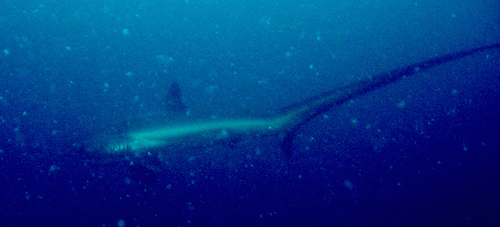After paying virtually no attention to wildlife in the previous 35 years, I’ve been amazed at how much my attitude has changed since I crossed the Pacific. I blame the Koalas. Ever since then I’ve been going more and more out of my way to find unusual things both on land and underwater.
Seeing the Tarsiers had fulfilled my terrestrial cravings for the moment, but I was soon hungering after a fix of big underwater action – so I headed north, to Malapascua, one of the few places in the world where you can relatively reliably dive with Thresher Sharks. I say reliably, but in fact I’d met a couple of people who’d tried on several occasions and failed. Despite hearing this slightly dispiriting news, I was determined to give it a go – this could be a once in a lifetime opportunity.
When you’ve been traveling for a while, it really feels like everything worth seeing inevitable involves an early morning start. The sharks were no exception – best time to see them is early morning, so I was up at half five to get on the boat at six, for what would turn out to be the most boring dive I’d ever done. There’s one place the sharks hang out, so we descended, sat on the bottom, and waited. And waited. There’s pretty much nothing else to see, and the visibility’s not great. And so we waited for about 40 minutes, and then gave up and came back up. But I wasn’t disheartened. I’d been prewarned that my chances weren’t high, so I remained cautiously hopeful (if not entirely optimistic) for the next day.
Yet again we had a pretty early start, and the dive started very similarly to the previous one. But half way through our luck changed, and a big shark swam right past us – our guide reckoned it was up to 4.5m long (with half of that being the huge, characteristic tail), and we got a good look at it as it slowly went by. That was the only one we saw that day, but that wasn’t it for the show, for a few big devil rays soon turned up and flew around for a while. Not quite as unusual as a thresher, I know, but seeing the devil rays confirmed my view that rays are the most beautiful, graceful creatures in the sea.
With mission accomplished, I felt like I’d earnt a beach day. And I honestly could not have wanted a better place for that than Malapascua. The island is pretty tiny, and sits off the north coast of Cebu, right in the heart of the Visayas. It’s probably my favourite island so far – in part because it’s the friendliest place in what is already the friendliest country I’ve ever been to. Everyone stops and says hello, everyone wants to help you out, and even the people selling stuff are low-pressure, friendly and chatty, preferring to win you over with charm and humour rather than trying to bludgeon you in to submission.
So my day on the beach turned out to be great fun, as we chatted to the local beach masseurs, made friends with the local beach dogs, watched the local men pruning the palm trees (can’t have falling coconuts ruining a tourist’s holiday, can you?) but best of all befriending the local kids. The beach kids on Malapascua were absolutely adorable, and they fussed around, wanting to listen to ipods, clamber over you in the sea while you try and cool off, and chase you round the beach (OK, so the day didn’t turn out quite as relaxing as I’d hoped, but was probably all the more fun because of it)
They were saving the best til last though – just before sunrise they put on an amazing acrobatic show for us, backflipping and somersaulting and cartwheeling down the beach, throwing each other up in the air, fearlessly reaching heights I’d be terrified by. It was pretty amazing stuff and reminded me you don’t need to spend forty minutes under water in scuba gear to see cool stuff. After all that hard work, they didn’t need to work hard at all to sell us stuff afterwards – we bought them all sodas, and then parted with more cash for the shells they were selling. Despite now having a bag full of shells I’m not sure what to do with now, it was a small price to pay for such a cool show.
You can see all of my photos of Malapascua here.
Next up: The final stop on my wildlife-spotting tour of the Philippines – chasing after Whale Sharks in Donsol.























































